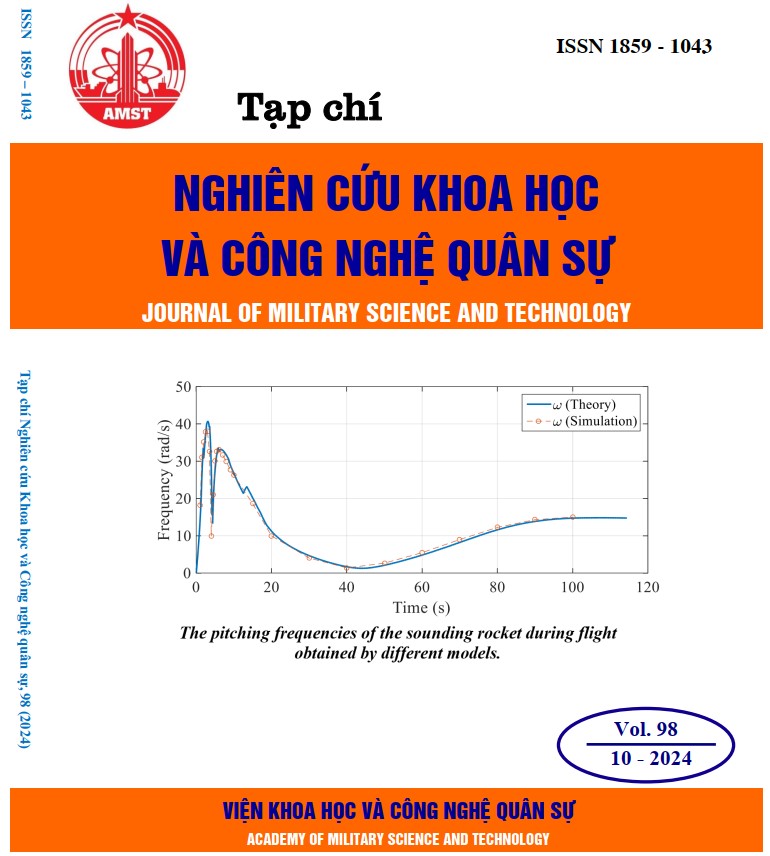Tổng hợp các bộ điều khiển trên cơ sở bất đẳng thức ma trận tuyến tính cho hệ thống nâng vật trong từ trường
351 lượt xemDOI:
https://doi.org/10.54939/1859-1043.j.mst.98.2024.61-68Từ khóa:
Hệ thống nâng vật trong từ trường; Bất đẳng thức ma trận tuyến tính; Điều khiển tích phân-phản hồi trạng thái; Điều khiển trượt.Tóm tắt
Bài báo này trình bày kết quả tổng hợp các bộ điều khiển trên cơ sở bất đẳng thức ma trận tuyến tính cho hệ thống nâng vật trong từ trường có mô hình toán học phi tuyến mạnh: điều khiển tích phân-phản hồi trạng thái và điều khiển trượt. Các kết quả mô phỏng so sánh và đánh giá các bộ điều khiển trên phần mềm MATLAB/Simulink đã cho thấy các bộ điều khiển hoạt động tốt và bền vững với sự thay đổi của khối lượng vật, vị trí của vật bám sát theo tín hiệu đặt. Tuy nhiên, trong các trường hợp các tham số của hệ thống thay đổi mạnh, hệ thống điều khiển với bộ điều khiển tích phân-phản hồi trạng thái có thể hoạt động không chính xác, thậm chí mất ổn định, còn bộ điều khiển trượt vẫn đảm bảo tính ổn định và bền vững với sự thay đổi của tham số hệ thống.
Tài liệu tham khảo
[1]. Cho D, Kato Y, Spilman D. “Sliding mode and classical control of magnetic levitation systems”. IEEE Control Syst Mag; 13(1):42–8, (1993). DOI: https://doi.org/10.1109/37.184792
[2]. Jayawant B. V., Sinha P. K., Aylwin D. G. “Feedback Control System for D.C. Electromagnets in Passenger-Carrying Vehicles”. Int J Control; 24(5):627–39, (1976). DOI: https://doi.org/10.1080/00207177608932851
[3]. Chamraz, Š.; Huba, M.; Žáková, K. “Stabilization of the Magnetic Levitation System”. Appl. Sci., 11, 10369, (2021). https://doi.org/10.3390/app112110369 DOI: https://doi.org/10.3390/app112110369
[4]. Hajjaji and M. Ouladsine, “Modeling and nonlinear control of magnetic levitation systems”, IEEE Transactions on Industrial Electronics 48, no. 4, 831–838, (2001). DOI: https://doi.org/10.1109/41.937416
[5]. R. Uswarman, A. I. Cahyadi and O. Wahyunggoro. “Control of a magnetic levitation system using feedback linearization”. 2013 International Conference on Computer, Control, Informatics and Its Applications, Jakarta, Indonesia, pp. 95-98, (2013). DOI: https://doi.org/10.1109/IC3INA.2013.6819156
[6]. B. Liu and W. Zhou. “Backstepping Based Nonlinear Adaptive Control of Magnetic Levitation System with Unknown Disturbances”. 2013 5th International Conference on Intelligent Human-Machine Systems and Cybernetics, Hangzhou, China, pp. 11-14, (2013). DOI: https://doi.org/10.1109/IHMSC.2013.9
[7]. Li J. H, Li J., Yu P. C, Wang L. C. “Adaptive backstepping control for levitation system with load uncertainties and external disturbances”. J. Cent. South Univ. 21, 4478–4488 (2014). DOI: https://doi.org/10.1007/s11771-014-2451-0
[8]. M. Lepetic, I. Skrjanc, H. G. Chiacchiarini and D. Matko. “Predictive control based on fuzzy model: a case study”. 10th IEEE International Conference on Fuzzy Systems. Melbourne, VIC, Australia, pp. 868-871 vol.3, (2001). DOI: https://doi.org/10.1109/FUZZ.2001.1009093
[9]. M. Jalili-Kharaajoo, M. M. Tousi, H. Bagherzadeh and A. E. Ashari. “Sliding mode control of voltage-controlled magnetic levitation systems”. Proceedings of 2003 IEEE Conference on Control Applications, 2003. CCA 2003., Istanbul, Turkey, pp. 83-86 vol.1, (2003). DOI: https://doi.org/10.1109/CCA.2003.1223267
[10]. Hafiz M., Syed A., Iftikhar A., Ali S. “Nonlinear adaptive control of magnetic levitation system using terminal sliding mode and integral backstepping sliding mode controllers”. ISA transactions 126, 121–133, (2022). DOI: https://doi.org/10.1016/j.isatra.2021.07.026
[11]. Pratik Vernekar, Vitthal Bandal. “Robust Sliding Mode Control of a Magnetic Levitation System: Continuous-Time and Discrete-Time Approaches”, Research Square, (2021). https://doi.org/10.21203/rs.3.rs-1011817/v1 DOI: https://doi.org/10.31224/osf.io/nqfyz
[12]. S. Boyd, L. El-Ghaoui, E. Feron, and V. Balakrishnan. “Linear Matrix Inequalities in System and Control Theory”. Philadelphia, PA: SIAM, (1994). DOI: https://doi.org/10.1137/1.9781611970777







